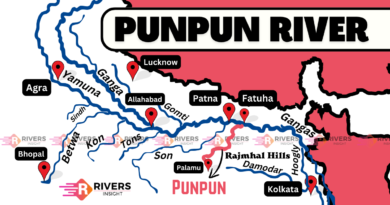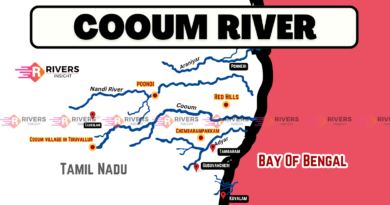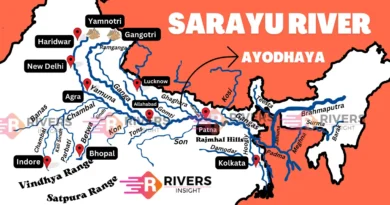Gomti River: Map with Tributaries
Gomti River is one of the major rivers of the northern Indian plains, flowing entirely through Uttar Pradesh. It starts in the Himalayan foothills and is a key tributary of the Ganga River. As a perennial river, the Gomti flows year-round, providing water for both farming and cities. With a total length of 940 kilometers, the Gomti eventually merges with the Ganga near Kaithi.
Table of Contents
Geographical Features of Gomti River
Origin and Course of Gomti River
The Gomti River originates from Gomath Tal (formerly known as Fulhar Jheel) near the town of Madho Tanda in Pilibhit district, Uttar Pradesh. From here, the river travels a distance of about 940 kilometers entirely in Uttar Pradesh before it merges with the Ganga River near Saidpur/Kaithi in Ghazipur district.
The river flows through the following districts in Uttar Pradesh:
- Pilibhit
- Shahjahanpur
- Hardoi
- Sitapur
- Lucknow
- Barabanki
- Sultanpur
- Jaunpur
- Ghazipur
The Gomti River originates near the Piedmont zone of the Ganga Plain, an area that contributes to the river’s flow and nourishment. Throughout its course, 23 major and minor tributaries feed into the river.
Key Tributaries
- Gaichi River (also known as Gaihaaee) – The first tributary of the Gomti, joining the river about 20 kilometers from its origin.
- Sukheta, Chuha, and Andhra Chuha – These small tributaries join the river at Mohammadi Kheri, about 100 km from its source.
- Kathana River – Joins the Gomti at Mailani.
- Sarayan River – Contributes to the Gomti near Lakhimpur.
- Sai River – A major tributary that merges with the Gomti near Rajepur in Jaunpur district.
- Kukrail Nala and Behta Nala – These tributaries meet the Gomti at Lucknow.
Finally, at the confluence of the Gomti and Ganga Rivers near Kaithi, the famous Markandey Mahadeo Temple is located, marking the river’s meeting with the Ganga.
Drainage Basin
The Gomti River Basin is an elongated area that spans more than 30,000 km². It lies within the Ghaghara–Ganga Interfluve (Doab) region, situated in the central part of the Ganga Plain.
Geographical Division
- Upper Basin: Includes Pilibhit, Lakhimpur Kheri, and Shahjahanpur districts.
- Central Basin: Includes Hardoi, Sitapur, Barabanki, Lucknow, and Unnao districts.
- Lower Basin: Includes Faizabad, Raebareli, Sultanpur, Pratapgarh, Jaunpur, and parts of Varanasi district.
The general trend of the basin runs northwest to southeast, nearly parallel to the Himalayan front.
Religious and Cultural Significance of the Gomti River
In Hindu tradition, the Gomti River is believed to be the daughter of Rishi Vashishtha, one of the great sages. Devotees believe that bathing in its waters, especially on Ekadashi (the 11th day of the lunar cycle), can wash away sins and purify the soul.
One of the most fascinating aspects of the Gomti River is the Gomti Chakra. This rare, circular object is actually the operculum, or protective covering, of a unique sea snail found in the Turbinidae family. Its name comes from the Sanskrit word “Chakra,” meaning “circle.”
For Hindus, the Gomti Chakra is considered a symbol of good fortune. People believe it brings wealth, health, and success. It’s also thought to offer special protection, especially for children, making it a cherished spiritual artifact.
This is all about the Gomti River, including its map, geographical features, and cultural significance. If you have any questions, queries, or feedback, feel free to share them—we’d be happy to hear from you!




